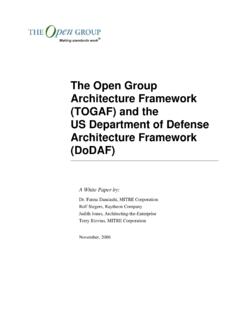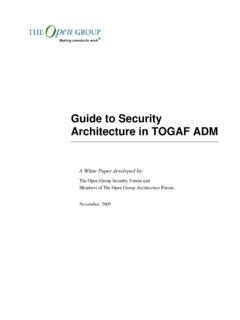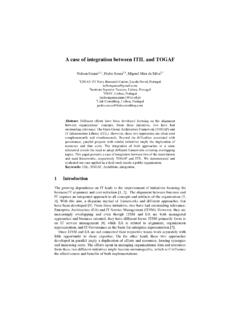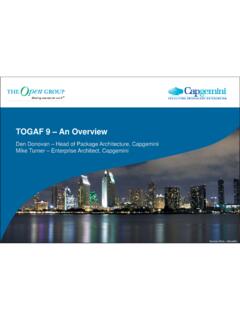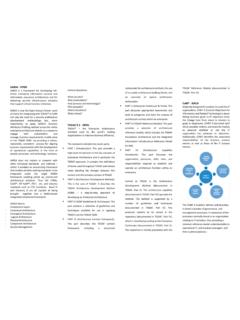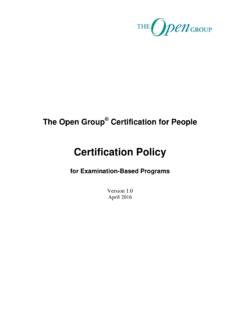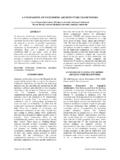Transcription of Integrating the TOGAF Standard with the BIAN Service …
1 Banking Industry Architecture Network & The Open Group Integrating the TOGAF Standard with the bian Service Landscape Author: TOGAF bian Collaboration Work Group Version: Last Change: Integrating the TOGAF Standard with the bian Service Landscape 2013 The Open Group and bian eV/PO Box 16 02 55 Page 2 of 38 60065 Frankfurt /Germany Organization Authors Role Name Company Author Paul Bonnie ING Author Thomas Obitz KPMG LLP (UK) Author Author Reference Documents Topic Type of Document Reference to Document TOGAF bian Service Landscape bian Metamodel Status Status Date Actor Comment/Reference Submitted Review Closure Approved Approved Version History Version Date of Change Author 7 December 2011 Paul Bonnie, Gerard Peters, Pierre-Philippe Delmarcelle, Thomas Obitz 15 October 2013 Paul Bonnie, Thomas Obitz Updated and made consistent with bian Service Landscape Integrating the TOGAF Standard with the bian Service Landscape 2013 The Open Group and bian eV/PO Box 16 02 55 Page 3 of 38 60065 Frankfurt /Germany Copyright 2013 The Open Group and bian eV.
2 All Rights Reserved. THIS DOCUMENT IS PROVIDED "AS IS," AND bian AND THE OPEN GROUP AND THEIR MEMBERS MAKE NO REPRESENTATIONS OR WARRANTIES, EXPRESS OR IMPLIED, INCLUDING BUT NOT LIMITED TO, WARRANTIES OF MERCHANTABILITY, FITNESS FOR A PARTICULAR PURPOSE, NON-INFRINGEMENT, OR TITLE; THAT THE CONTENTS OF THIS DOCUMENT ARE SUITABLE FOR ANY PURPOSE; OR THAT THE IMPLEMENTATION OF SUCH CONTENTS WILL NOT INFRINGE ANY PATENTS, COPYRIGHTS, TRADEMARKS, OR OTHER RIGHTS. NEITHER bian AND THE OPEN GROUP NOR THEIR MEMBERS WILL BE LIABLE FOR ANY DIRECT, INDIRECT, SPECIAL, INCIDENTAL, OR CONSEQUENTIAL DAMAGES ARISING OUT OF OR RELATING TO ANY USE OR DISTRIBUTION OF THIS DOCUMENT UNLESS SUCH DAMAGES ARE CAUSED BY WILFUL MISCONDUCT OR GROSS NEGLIGENCE.
3 THE FOREGOING DISCLAIMER AND LIMITATION ON LIABILITY DO NOT APPLY TO, INVALIDATE, OR LIMIT REPRESENTATIONS AND WARRANTIES MADE BY THE MEMBERS TO bian AND THE OPEN GROUP AND OTHER MEMBERS IN CERTAIN WRITTEN POLICIES OF bian AND THE OPEN GROUP. Boundaryless Information Flow is a trademark and ArchiMate , Jericho Forum , Motif , Making standards Work , OSF/1 , The Open Group , TOGAF , UNIX , and the X device are registered trademarks of The Open Group in the United States and other countries. All other brands, company, and product names are used for identification purposes only and may be trademarks that are the sole property of their respective owners. Integrating the TOGAF Standard with the bian Service Landscape 2013 The Open Group and bian eV/PO Box 16 02 55 Page 4 of 38 60065 Frankfurt /Germany Table of Contents 1 Introduction.
4 7 Re-Architecting the Banking Industry .. 7 TOGAF and bian Initiatives .. 7 White Paper Objectives .. 7 White Paper Structure .. 8 Future Evolution of this White Paper .. 8 2 Drivers in the Banking Industry .. 9 External Business, Market and Regulatory Drivers .. 9 Responses of Banks .. 9 Impact on the IT Landscape of Banks .. 10 Implied Change in IT .. 10 3 Enterprise Architecture .. 12 Development of Enterprise Architecture Discipline .. 12 Challenges for Enterprise Architects in a Banking Environment .. 12 4 bian A Business Service Model for the Banking Industry .. 13 bian Vision and Strategy .. 13 bian Deliverables.
5 13 bian Metamodel .. 14 Metamodel Viewpoint: The bian Service Landscape .. 14 Metamodel Viewpoint: Business Objects .. 14 Metamodel Viewpoint: Message .. 14 bian Service Landscape .. 14 bian Service Domain Specifications .. 16 bian Business Scenarios .. 16 5 TOGAF The Leading Framework for Enterprise Architecture .. 18 The Open Group .. 18 TOGAF as an Industry-Independent Framework for Enterprise Architecture .. 18 Overview of TOGAF Components .. 18 TOGAF Architecture Development Method (Part II) .. 20 Architecture Content Framework (Part IV) .. 20 TOGAF Enterprise Continuum (Part V) .. 21 6 Leveraging the bian Deliverables with TOGAF .
6 22 Introduction .. 22 Relating bian to the Phases of the ADM (Part II) .. 22 Preliminary Phase (Chapter 6) .. 22 Architecture Vision (Phase A, Chapter 7) .. 23 Business Architecture (Phase B, Chapter 8) .. 23 Information Systems Architecture (Phase C, Chapter 9) .. 23 Integrating the TOGAF Standard with the bian Service Landscape 2013 The Open Group and bian eV/PO Box 16 02 55 Page 5 of 38 60065 Frankfurt /Germany Technology Architecture (Phase D, Chapter 12) .. 24 Opportunities and Solutions (Phase E, Chapter 13) .. 24 Migration Planning (Phase F, Chapter 14) .. 24 Implementation Governance (Phase G, Chapter 15) .. 24 Architecture Change Management (Phase H, Chapter 16).
7 25 Requirements Management (Chapter 17) .. 25 Relating bian to TOGAF Guidelines and Techniques (Part III) .. 25 Applying the ADM at Different Enterprise Levels (Chapter 20) .. 25 Using TOGAF to Define and Govern SOAs (Chapter 22) .. 26 Architecture Principles (Chapter 23) .. 26 Architecture Patterns (Chapter 25) .. 27 Interoperability Requirements (Chapter 29) .. 27 bian and the TOGAF Architecture Content Framework (Part IV) .. 27 Deliverables, Artifacts, and Building Blocks .. 27 Mapping the bian Deliverables to the TOGAF Content Metamodel .. 28 bian and the TOGAF Enterprise Continuum (Part V) .. 30 7 Other Relevant standards for the Banking Industry.
8 31 Alignment of bian with Other Technical, Semantic, and Messaging standards .. 31 8 Glossary .. 32 9 APPENDIX: The bian Metamodel .. 34 Service Landscape Viewpoint .. 34 Business Object Viewpoint .. 36 Message Viewpoint .. 36 Scenario Viewpoint .. 38 Integrating the TOGAF Standard with the bian Service Landscape 2013 The Open Group and bian eV/PO Box 16 02 55 Page 6 of 38 60065 Frankfurt /Germany Management Summary Since the first release of this paper in 2011, it has become clear that states (as represented by regulators) have fundamentally re-shaped the market place for financial institutions. As banks switch back into growth mode, they realize that they need to re-allocate resources to thrive in the new environment.
9 New and changing business models and strategies trigger major initiatives at operational and IT level. Organizations require an approach to plan these initiatives as integrated transformations across the organization. They want to ensure they are delivering the right capabilities, and they want to ensure they are delivering these initiatives reliably at adequate cost. As a result, Enterprise Architecture has become an approach which is highly in demand. The role of Enterprise Architecture is further emphasized by regulations recognizing its benefit in terms of transparency. As an example, a recent publication of the Bank for International Settlement1 urges banks to strengthen their IT and data architecture considerably to provide top management and regulators with a consistent group-wide view of risk exposure.
10 A similar call was made by the Commission on the Structure of Dutch Banks as the Commission has sought to explore the benefits of an Enterprise Architecture in ensuring the stability of the Dutch banking sector2. This White Paper aims at supporting Enterprise Architects within the banking industry, reaping the synergies of two complementary industry frameworks: TOGAF , an Open Group Standard , is a proven Enterprise Architecture methodology and framework used by leading global organizations to improve business efficiency. bian , the Banking Industry Architecture Network, delivers an overall framework and set of IT Service definitions and bian Business Scenarios specific to the banking industry, aimed at improving systems interoperability.

